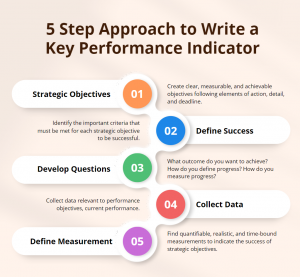If you work in corporate training, you have probably heard the term KPIs. But what are KPIs and what are they used for?
KPIs stand for Key Performance Indicators. They are the critical indicators of progress toward an intended result. They are often used by training managers to help them measure learning and the effectiveness of training programmes. Simply put, they are the reason for running a course and the means to evaluate if the training has had a positive effect on achieving the objective.
Here is a visual representation of how KPIs can be created:

Key Performance Indicators
A practical example of Key Performance Indicators
Let’s imagine that certain people in a company need to attend international conferences and deliver presentations in English. However, feedback on these presentations is not good. It has been noted that the presentations are not easy to follow because of the level of English of the presenters. The company decides to commission the services of a language training specialist to change this. The training has three clear objectives: to help the presenters deliver talks in a clear, register-appropriate and engaging way in English.
In order to evaluate learning and improved performance, the participants in the course need to be assessed both prior to training and after training using the same criteria. In our example, the course participants would need to be evaluated on clarity, register and audience engagement in the delivery of their presentations in English.
It is important for language teaching organisations to find out whether corporate clients will use KPIs to measure the effectiveness of a course and to set realistic expectations. The teachers delivering the course also need to be involved in the dialogue about the KPIs to ensure that the training is focused on making improvements in these specific areas.
The difference between KPIs and Learning Analytics
Key Performance Indicators tend to be different from Learning Analytics. Learning Analytics is the more granular data provided by language teaching organisations to prove that learning has taken place. Typically, the data includes results of tests or exam results and can be broken down into specific language areas e.g. Vocabulary, Grammar, Functional Language, reading skills, listening skills, writing skills and speaking skills.
Learning analytics is normally presented to training managers by the language teaching organisations. Key Performance Indicators, on the other hand, are normally analysed by the training manager and are closely linked to the specific training needs and goals.
Communication is key
The important thing is that there is an open and frank dialogue between the language training organisation and the training manager or learning and development manager of the company about the goals of the training. For training to be successful we need to ensure that realistic objectives for the language training are both set and met.
Do you need help to achieve your language learning objectives?
If you represent a company or institution and are interested in finding out how we can help you achieve your language learning objectives using KPIs, fill in this form and we’ll set up a call.
